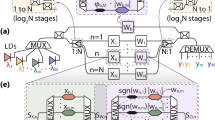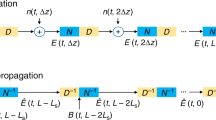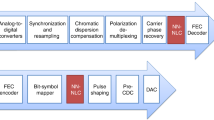Abstract
In optical communication systems, fibre nonlinearity is the major obstacle in increasing the transmission capacity. Typically, digital signal processing techniques and hardware are used to deal with optical communication signals, but increasing speed and computational complexity create challenges for such approaches. Highly parallel, ultrafast neural networks using photonic devices have the potential to ease the requirements placed on digital signal processing circuits by processing the optical signals in the analogue domain. Here we report a silicon photonic–electronic neural network for solving fibre nonlinearity compensation in submarine optical-fibre transmission systems. Our approach uses a photonic neural network based on wavelength-division multiplexing built on a silicon photonic platform compatible with complementary metal–oxide–semiconductor technology. We show that the platform can be used to compensate for optical fibre nonlinearities and improve the quality factor of the signal in a 10,080 km submarine fibre communication system. The Q-factor improvement is comparable to that of a software-based neural network implemented on a workstation assisted with a 32-bit graphic processing unit.
This is a preview of subscription content, access via your institution
Access options
Access Nature and 54 other Nature Portfolio journals
Get Nature+, our best-value online-access subscription
$29.99 / 30 days
cancel any time
Subscribe to this journal
Receive 12 digital issues and online access to articles
$119.00 per year
only $9.92 per issue
Buy this article
- Purchase on Springer Link
- Instant access to full article PDF
Prices may be subject to local taxes which are calculated during checkout





Similar content being viewed by others
Data availability
All data used in this study are available from the corresponding authors upon reasonable request.
Code availability
All codes used in this study are available from the corresponding authors upon reasonable request.
References
Najafabadi, M. M. et al. Deep learning applications and challenges in big data analytics. J. Big Data 2, 1 (2015).
Deng, L. et al. Deep learning: methods and applications. Found. Trends Signal Process. 7, 197–387 (2014).
De Lima, T. F. et al. Machine learning with neuromorphic photonics. J. Lightwave Technol. 37, 1515–1534 (2019).
Wang, Y. & Boyd, S. Fast model predictive control using online optimization. IEEE Trans. Control Syst. Technol. 18, 267–278 (2009).
Shi, Y. et al. Deep learning for RF signal classification in unknown and dynamic spectrum environments. In 2019 IEEE International Symposium on Dynamic Spectrum Access Networks (DySPAN) 1–10 (IEEE, 2019).
Zibar, D., Piels, M., Jones, R. & Scha¨effer, C. G. Machine learning techniques in optical communication. J. Lightwave Technol. 34, 1442–1452 (2015).
Khan, F. N., Fan, Q., Lu, C. & Lau, A. P. T. An optical communication’s perspective on machine learning and its applications. J. Lightwave Technol. 37, 493–516 (2019).
Zhang, S. et al. Field and lab experimental demonstration of nonlinear impairment compensation using neural networks. Nat. Commun. 10, 3033 (2019).
Ip, E. & Kahn, J. M. Compensation of dispersion and nonlinear impairments using digital backpropagation. J. Lightwave Technol. 26, 3416–3425 (2008).
Giacoumidis, E., Lin, Y., Blott, M. & Barry, L. P. Real-time machine learning based fiber- induced nonlinearity compensation in energy-efficient coherent optical networks. APL Photon. 5, 041301 (2020).
Morero, D. A., Castrillon, M. A., Aguirre, A., Hueda, M. R. & Agazzi, O. E. Design tradeoffs and challenges in practical coherent optical transceiver implementations. J. Lightwave Technol. 34, 121–136 (2016).
Du, L. B. et al. Digital fiber nonlinearity compensation: toward 1-Tb/s transport. IEEE Signal Process. Mag. 31, 46–56 (2014).
Prucnal, P. R. & Shastri, B. J. Neuromorphic Photonics (CRC Press, 2017).
Shastri, B. J. et al. Photonics for artificial intelligence and neuromorphic computing. Nat. Photon. 15, 102–114 (2021).
Brunner, D. & Fischer, I. Reconfigurable semiconductor laser networks based on diffractive coupling. Opt. Lett. 40, 3854–3857 (2015).
Zuo, Y. et al. All-optical neural network with nonlinear activation functions. Optica 6, 1132–1137 (2019).
Hill, M. T., Frietman, E. E., de Waardt, H., Khoe, G.-D. & Dorren, H. J. All fiber-optic neural network using coupled SOA based ring lasers. IEEE Trans. Neural Netw. 13, 1504–1513 (2002).
Fok, M. P. et al. Signal feature recognition based on lightwave neuromorphic signal processing. Opt. Lett. 36, 19–21 (2011).
Brunner, D., Soriano, M. C., Mirasso, C. R. & Fischer, I. Parallel photonic information processing at gigabyte per second data rates using transient states. Nat. Commun. 4, 1364 (2013).
Lin, X. et al. All-optical machine learning using diffractive deep neural networks. Science 361, 1004–1008 (2018).
Bueno, J. et al. Reinforcement learning in a large-scale photonic recurrent neural network. Optica 5, 756–760 (2018).
Tait, A. N. et al. Neuromorphic photonic networks using silicon photonic weight banks. Sci. Rep. 7, 7430 (2017).
Peng, H.-T., Nahmias, M. A., De Lima, T. F., Tait, A. N. & Shastri, B. J. Neuromorphic photonic integrated circuits. IEEE J. Sel. Topics Quantum Electron. 24, 1–15 (2018).
Shen, Y. et al. Deep learning with coherent nanophotonic circuits. Nat. Photon. 11, 441–446 (2017).
Feldmann, J., Youngblood, N., Wright, C. D., Bhaskaran, H. & Pernice, W. All-optical spiking neurosynaptic networks with self-learning capabilities. Nature 569, 208–214 (2019).
Vandoorne, K. et al. Experimental demonstration of reservoir computing on a silicon photonics chip. Nat. Commun. 5, 3541 (2014).
Tait, A. N. et al. Silicon photonic modulator neuron. Phys. Rev. Appl. 11, 064043 (2019).
Huang, C. et al. On-chip programmable nonlinear optical signal processor and its applications. IEEE J. Sel. Topics Quantum Electron. 27, 1–11 (2020).
Essiambre, R.-J., Kramer, G., Winzer, P. J., Foschini, G. J. & Goebel, B. Capacity limits of optical fiber networks. J. Lightwave Technol. 28, 662–701 (2010).
Tao, Z. et al. Multiplier-free intrachannel nonlinearity compensating algorithm operating at symbol rate. J. Lightwave Technol. 29, 2570–2576 (2011).
Jouppi, N. P. et al. In-datacenter performance analysis of a tensor processing unit. In Proceedings of the 44th Annual International Symposium on Computer Architecture (ISCA '17). Association for Computing Machinery, New York, NY, USA, 1–12.
Sun, J., Timurdogan, E., Yaacobi, A., Hosseini, E. S. & Watts, M. R. Large-scale nanophotonic phased array. Nature 493, 195–199 (2013).
Poulton, C. V. et al. 8192-element optical phased array with 100° steering range and flip-chip CMOS. In CLEO: Applications and Technology JTh4A.3 (Optical Society of America, 2020).
Tait, A. N. et al. Feedback control for microring weight banks. Opt. Express 26, 26422–26443 (2018).
Huang, C. et al. Demonstration of scalable microring weight bank control for large-scale photonic integrated circuits. APL Photon. 5, 040803 (2020).
Zhang, W. et al. Microring weight banks control beyond 8.5-bits accuracy. Preprint at https://arxiv.org/abs/2104.01164 (2021).
Hai, M. S., Sakib, M. N. & Liboiron-Ladouceur, O. A 16 GHz silicon-based monolithic balanced photodetector with on-chip capacitors for 25 Gbaud front-end receivers. Opt. Express 21, 32680–32689 (2013).
Kingma, D. P. & Ba, J. Adam: a method for stochastic optimization. Preprint at https://arxiv.org/abs/1412.6980 (2014).
Carroll, L. et al. Photonic packaging: transforming silicon photonic integrated circuits into photonic devices. Appl. Sci. 6, 426 (2016).
Atabaki, A. H., Eftekhar, A. A., Askari, M. & Adibi, A. Accurate post-fabrication trimming of ultra-compact resonators on silicon. Opt. Express 21, 14139–14145 (2013).
Wang, Z. et al. In situ training of feed-forward and recurrent convolutional memristor networks. Nat. Mach. Intell. 1, 434–442 (2019).
Brasch, V. et al. Photonic chip–based optical frequency comb using soliton Cherenkov radiation. Science 351, 357–360 (2016).
de Lima, T. F. et al. Noise analysis of photonic modulator neurons. IEEE J. Sel. Topics Quantum Electron. 26, 1–9 (2019).
Nozaki, K. et al. Femtofarad optoelectronic integration demonstrating energy-saving signal conversion and nonlinear functions. Nat. Photon. 13, 454–459 (2019).
Nahmias, M. A. et al. Photonic multiply-accumulate operations for neural networks. IEEE J. Sel. Topics Quantum Electron. 26, 1–18 (2019).
Tait, A. N., Nahmias, M. A., Shastri, B. J. & Prucnal, P. R. Broadcast and weight: an integrated network for scalable photonic spike processing. J. Lightwave Technol. 32, 4029–4041 (2014).
Acknowledgements
This research is supported by the Office of Naval Research (ONR) (N00014-18-1-2297), Defense Advanced Research Projects Agency (HR00111990049), National Science Foundation (NSF) (grant nos. ECCS 1642962 and DGE 1148900) and CUHK Research Direct Grant (170257018). The devices were fabricated at the IME A*STAR foundry, Singapore. Fabrication support was provided by the Natural Sciences and Engineering Research Council of Canada (NSERC) Silicon Electronic-Photonic Integrated Circuits (SiEPIC) Program and the Canadian Microelectronics Corporation (CMC).
Author information
Authors and Affiliations
Contributions
C.H., S.F. and T.F.L. conceived the ideas and implemented the experimental setup, designed the experiment, conducted the experimental measurements and analysed the results. C.H., T.F.L. E.C.B., S.B., A.J. and H.-T.P. designed the silicon photonic chip. A.N.T., Y.T., F.Y. and B.J.S. provided the theoretical support. T.F.L., E.C.B. and S.B. performed the chip packaging. C.H., S.F., T.F.L., A.N.T. and B.J.S. wrote the manuscript. T.W. and P.R.P. supervised the research and contributed to the general concept and interpretation of the results. All the authors discussed the data and contributed to the manuscript.
Corresponding authors
Ethics declarations
Competing interests
The authors declare no competing interests.
Additional information
Peer review information Nature Electronics thanks José Capmany and the other, anonymous, reviewer(s) for their contribution to the peer review of this work.
Publisher’s note Springer Nature remains neutral with regard to jurisdictional claims in published maps and institutional affiliations.
Supplementary information
Supplementary Information
Supplementary Figs. 1–3, Tables 1–4 and Discussion.
Rights and permissions
About this article
Cite this article
Huang, C., Fujisawa, S., de Lima, T.F. et al. A silicon photonic–electronic neural network for fibre nonlinearity compensation. Nat Electron 4, 837–844 (2021). https://doi.org/10.1038/s41928-021-00661-2
Received:
Accepted:
Published:
Issue Date:
DOI: https://doi.org/10.1038/s41928-021-00661-2
This article is cited by
-
Roadmapping the next generation of silicon photonics
Nature Communications (2024)
-
Integrated lithium niobate microwave photonic processing engine
Nature (2024)
-
High-efficiency reinforcement learning with hybrid architecture photonic integrated circuit
Nature Communications (2024)
-
A system-on-chip microwave photonic processor solves dynamic RF interference in real time with picosecond latency
Light: Science & Applications (2024)
-
Analog spatiotemporal feature extraction for cognitive radio-frequency sensing with integrated photonics
Light: Science & Applications (2024)



